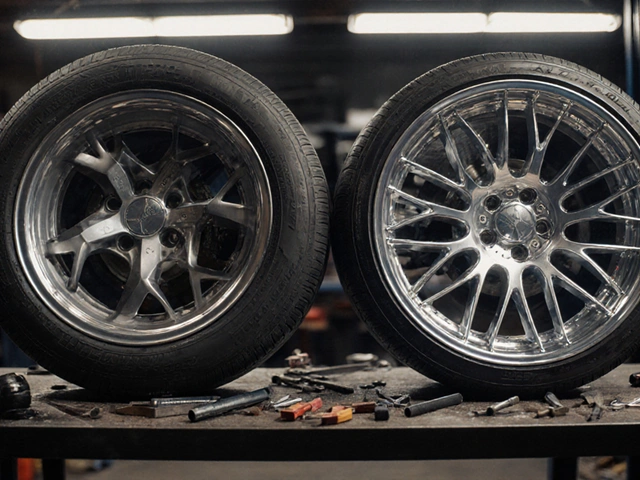So, you're sporting alloy wheels on your ride - they're sleek, they're shiny, but they're not invincible. It's important to know just how much punishment they can take before throwing in the towel. Can they be repaired, and if so, how many times?
Before diving in, let's get one thing straight: alloy wheels, while stylish, are more delicate than the old steel wheels many cars used to sport. They're prone to dings, scratches, and if you live in a pothole-prone area, you might have encountered a nasty bend or two.
The real question is, how many times can you fix them up before they need to be tossed? It largely depends on the type and extent of the damage. Surface scratches and minor scuffs can often be buffed away or filled several times, whereas structural damage like cracks or severe bends might limit your options.
Understanding Alloy Wheels
First things first, let's demystify what alloy wheels actually are. They're made from a mixture of metals, mainly aluminum or magnesium, which makes them lighter and often better looking than their steel counterparts. These materials provide a nice balance between durability and aesthetics, which is why they're so popular.
Why choose alloy in the first place? Well, a few reasons stand out:
- Performance: Being lighter, they can improve a car's handling and performance. Less weight means less inertia when turning - your car feels more responsive.
- Fuel Efficiency: They're not just about looks and speed; they can also help in squeezing those extra kilometers from your tank thanks to reduced weight.
- Heat Conduction: Built-in cooling properties mean better heat dissipation, which keeps the brakes cooler during operation. No more worrying about brakes overheating on long drives or sudden stops!
Despite these perks, they're prone to damage due to their more delicate nature compared to steel. They can't always take the same knocks and bumps without showing signs of wear and tear, though.
Let's talk numbers for a moment:
| Property | Alloy Wheels | Steel Wheels |
|---|---|---|
| Weight | Lighter | Heavier |
| Heat Dissipation | Better | Average |
| Durability Against Impacts | Lower | Higher |
Ultimately, understanding the strengths and weaknesses of alloy wheels can help you decide how to handle them. But keeping them in top shape means knowing the damage types they're susceptible to, which we'll cover next.
Types of Damage
Alloy wheels can encounter different types of damage over their lifespan. Understanding what you're dealing with can make all the difference when deciding between repair and replacement.
Scuffs and Scratches
The most common complaints among alloy wheel owners are scuffs and scratches. These usually happen when you brush against a curb, parking misjudgments, or debris on the road. Fortunately, these are mostly cosmetic issues that can often be fixed with a bit of buffing or a fresh coat of paint.
Dents and Bends
Dents and bends are a bigger headache and usually occur after hitting a pothole or a fender bender. While small to moderate bends can still be fixed by a skilled technician using specialized equipment, severe bends might affect the wheel balance and pose a safety risk. In such cases, replacement often becomes the only safe option.
Cracks
Now, cracks are where things get serious. Cracks can develop from repeated stress or a particularly nasty impact. Repairing a crack is tricky because it compromises the alloy wheel's structural integrity. Sometimes, welding can fix minor cracks, but it's crucial to ensure the repair doesn't weaken the wheel further. Many experts recommend replacing a cracked wheel to ensure safety.
Corrosion
Alloy wheels, while durable, can suffer corrosion over time, especially if not maintained properly. This is more common in harsh weather or salty environments and can lead to pitting and eventual weakening of the wheel structure. Regular cleaning and protective coatings can help prevent this, but once corrosion takes hold, repair can be challenging and costly.
With these damages, it's clear that the type and extent of damage play a crucial role in determining whether you should repair or replace your alloy wheels. Always consult with a professional to assess the specific damage and suggest the safest solution.

Repair Limits
Okay, so just how many times can you fix up those alloy wheels before they can't take it anymore? It's a fair question and one that depends on a few key factors. First and foremost, the type of damage makes a big difference.
Surface Damage Repair
For those little scuffs and scratches, you can usually go through the repair process multiple times. These repairs often involve sanding, filling, and repainting. Think of it like mending a scratch on a wooden table. You sand it down, apply filler, and add a fresh coat. Pretty straightforward, and as long as the aesthetic damage doesn't get too deep, you can repeat this process without much hassle.
Structural Damage Concerns
But what about when things get more serious? A bent wheel from a hefty pothole or curb? Here, the limitations really kick in. Structural damage such as bends or cracks is concerning because it affects the safety and performance of your wheel. You can safely repair a bend a few times, but each repair slightly weakens the integrity of the wheel. If a wheel has been bent back more than two or three times, it's often best to think about replacement.
Cracks Are a Different Beast
Now, if your wheel has a crack, that's a big red flag. Cracks, even small ones, can jeopardize safety. Some shops may offer welding solutions, but this is generally a one-time fix. It's not advisable to repair a cracked wheel more than once, if at all, because the risk of failure, which could lead to an accident, is just too high.
Using Professional Help
Keep in mind, it's vital to get a professional opinion. A skilled technician can assess whether the damage is purely cosmetic or if it undermines the wheel's strength. Be sure to ask about warranty coverage on repairs, and definitely, don't try a DIY fix for structural issues.
To wrap up, maintaining the integrity of your alloy wheels often means accepting their repair limits. If you're continually facing similar damage, it might be time to reconsider the roads you're driving on or even your driving style. Symptoms of needing a replacement include frequent air loss, noticeable vibrations, or consistent balance issues. Listen to your car - it often tells you what it needs.
Safety Considerations
When dealing with alloy wheels, safety is a biggie you can't ignore. Sure, you might want to save some bucks fixing those bad boys, but sometimes, cutting corners could put more than just your wheels at risk.
First off, consider the type of damage. If the wheel is structurally compromised—think cracks or major bending—repairs might not cut it. A cracked wheel, even if patched, could fail when you least expect it, leading to potential accidents.
Watch Out for the Cracks
Cracks are a deal-breaker. While some repair shops might offer solutions, remember this: a repaired crack can weaken the overall integrity of the wheel. You can fix superficial stuff, but structural damage is an entirely different beast.
Balance and Alignment
Each time you repair a rim, you might inadvertently alter its balance and alignment. Get your wheels professionally balanced and aligned after each repair. It ensures even tire wear and avoids steering problems or vibrations at certain speeds.
Know the Limitations
- If a wheel has been repaired multiple times, its durability decreases over time.
- A wheel that wobbles after repair means there's underlying damage still affecting your ride.
- Industry experts often suggest replacing an alloy wheel if it's been repaired more than two to three times.
For peace of mind, some experts suggest using repaired wheels as spares, not your daily drivers. Knowing when to switch a repaired wheel to an occasional usage can keep you and your vehicle safer on the road.
Certified Repairs
If you go ahead with a repair, make sure to choose a repair service that's certified and experienced with alloy wheels. Experienced hands can make a world of difference.
Remember, it's not just about fixing a wheel to look pretty. Properly addressing damage and knowing when to stop relying on repairs can be the difference between a smooth drive and a dangerous mishap.

When to Replace
Knowing when to replace your alloy wheels isn't just about keeping your car looking sharp. It's about safety and performance too. Here's how you can tell if it's time to give them the boot and invest in a fresh set.
Signs You Need a Replacement
If you notice any cracks, even if they're small, it's usually a strong indicator that a replacement is on the horizon. Cracks can compromise the wheel's integrity, and it's often too risky to attempt repairs.
Bent wheels are another issue. While a small bend might be fixed, anything major or if you've had it corrected more than once, could be a sign that your wheel is on borrowed time.
- Visible cracks - Never ignore them as they can lead to catastrophic failure.
- Recurrent bending - If it's happened a few times, the structure might not hold for long.
- Severe corrosion or rusting - This is quite rare in alloy but watch for pitting or flaking, especially in coastal areas.
Performance and Comfort
Has your car been riding rough lately? Vibrations, wobbles, or even strange noises could point to a problem with one or more wheels. An ill-repaired wheel can throw off balance and alignment, leading to increased tire wear and a less comfortable ride.
Choosing to replace rather than repair can sometimes be a smarter financial decision. Patch repairs on severely damaged wheels can add up, and if the repairs aren't effective, those costs will spiral quickly.
Table of Replacement Costs
| Wheel Type | Average Replacement Cost |
|---|---|
| Basic Alloy Wheels | $100 - $200 each |
| Performance Alloy Wheels | $200 - $500 each |
| Custom Alloy Wheels | $500 and up |
So, keep an eye on these indicators and don't hesitate to get a professional opinion if you're on the fence. Remember, it's not just about aesthetics - it's your safety and comfort on the line.




